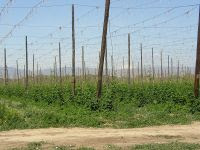
The old argument goes that the demand for corn for ethanol production has caused farmers to switch from growing other crops to grow corn. And it seems that any and all price increases can be explained this way without anyone questioning it. Not even when all the numbers suggest that it is incorrect. Take this recent
article on why beer prices are going up.
A worldwide shortage of hops has depleted the supplies available to brewers, particularly for some of the specific blends that craft brewers have made their specialties. The shortage is the result of recent drought in Australia and flooding in Europe that destroyed much of their crops, forcing brewers overseas to turn to U.S. hops supplies that already were strained by a movement to plant more profitable crops like corn.
This all seems logical doesn't it? But the next sentence in the article should have raised a red flag.
Coupled with rising fuel costs, the shortage has hops prices skyrocketing from $5 per pound to as much as $45.
It is hard to see how corn that is currently selling for around $6 per bushel could be more profitable than hops that sell for even the lower number of $5 per pound.
So lets look at how much a farmer could expect to make raising corn. Last year the average corn yield was 151 bushels per acre and the average price was $4.00 per bushel. So a corn farmer would make $604 per acre.
Last year the average hops yield was 1,949 pounds per acre and the average price was $2.81 per pound. So a hops farmer would make $5,477 per acre.
Something tells me that the reporter didn't do their homework on this issue. A quick look at the
USDA website provided that information.
A little more study would have told the reporter that hops are perennial plants that grow on upright structures. So to say that farmers have switched from growing them to grow corn would be like saying that farmers switched from growing grapes to grow corn.
The primary region for growing hops is Pacific Northwest, with Washington state being the top producer. That region isn't really known for it's corn production.
Then of course there is the small matter of hops farmers not having the proper equipment to plant and harvest corn.
And one last thing, according to the USDA the amount of hops acres were up last year by about 1,500 acres or about 5% over 2006.
To be fair the author never mentioned ethanol in the article but I think he followed the same general mindset that many have in blaming corn. It seems that someone will try to link any and all price increases to ethanol in some way or another these days. But as a member of the general public being fed this information, I think we should be able to expect that it at least be a little more realistic.
 As we all know commodity prices have been increasing and that many food manufacturers have made the claim that ethanol is to blame. And while the extent to which ethanol is responsible for higher food prices is up for debate, this could also be the perfect situation for food manufactures to increase prices in excess of what input costs dictate in order to increase their profits. Food Before Profit attempts to hold food manufacturers accountable for such practices.
As we all know commodity prices have been increasing and that many food manufacturers have made the claim that ethanol is to blame. And while the extent to which ethanol is responsible for higher food prices is up for debate, this could also be the perfect situation for food manufactures to increase prices in excess of what input costs dictate in order to increase their profits. Food Before Profit attempts to hold food manufacturers accountable for such practices. Food Price Truth was developed to counter the public relations campaign being waged against biofuels by the Grocery Manufacturers Association. Their goal is to provide a clearinghouse of information designed to set the record straight on the domestic and worldwide food crisis.
Food Price Truth was developed to counter the public relations campaign being waged against biofuels by the Grocery Manufacturers Association. Their goal is to provide a clearinghouse of information designed to set the record straight on the domestic and worldwide food crisis.
 The opponents of ethanol argue that even though most of the corn from which ethanol is made isn't eaten directly by humans, that diverting corn to ethanol creates higher meat, egg, and diary prices by making livestock feed more costly.
The opponents of ethanol argue that even though most of the corn from which ethanol is made isn't eaten directly by humans, that diverting corn to ethanol creates higher meat, egg, and diary prices by making livestock feed more costly. By now I guess everyone has heard about the high profile public relations
By now I guess everyone has heard about the high profile public relations  James Perdue, chairman of Perdue Incorporated, a large poultry producer made some interesting
James Perdue, chairman of Perdue Incorporated, a large poultry producer made some interesting  The Agricultural Utilization Research Institute just finished a study that shows that ethanol plants could displace most of their energy needs through anaerobic digestion of thin stillage.
The Agricultural Utilization Research Institute just finished a study that shows that ethanol plants could displace most of their energy needs through anaerobic digestion of thin stillage. The old argument goes that the demand for corn for ethanol production has caused farmers to switch from growing other crops to grow corn. And it seems that any and all price increases can be explained this way without anyone questioning it. Not even when all the numbers suggest that it is incorrect. Take this recent
The old argument goes that the demand for corn for ethanol production has caused farmers to switch from growing other crops to grow corn. And it seems that any and all price increases can be explained this way without anyone questioning it. Not even when all the numbers suggest that it is incorrect. Take this recent  The number of E85 stations across the country increased to 1579 in May.
The number of E85 stations across the country increased to 1579 in May.